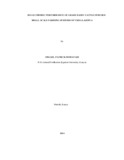Bio-economic performance of grade dairy cattle in mixed small scale farming systems of Vihiga, Kenya
Abstract
This study examined the influence of existing grade dairy cattle production factors and systems
on bio-economic performance of grade dairy cattle in the mixed small scale farming systems of
Vihiga, Kenya. Whilst there is an increasing interest in smallholder grade dairy cattle
production, at the same time information on bio-economic performance under the different
grade dairy cattle production systems from the producers’ perspective is scanty. Detailed data
on the farm system, resources and bio-economic performance parameters was collected using a
pre-tested structured questionnaire at the household level from a purposive sample of 236 grade
dairy cattle owning households in Vihiga between April-August 2005. The data was entered in
MS Excel spreadsheet and subjected to SPSS (Version 10.0) for ANOVA, descriptive statistics
and frequencies based on the existing grade dairy cattle production systems.
The Dairy Simulation Model v3.2, which is part of the Livestock Feeding Simulation “LIFESIM”
Modelsgroup, gross margin and benefit-cost analysis were used to quantify the influence
of existing grade dairy cattle production factors and systems on bio-economic performance.
Land sizes in Vihiga were small (2.27 acres), hence grade dairy cattle production systems were
mainly intensive (stall feeding only and mainly stall feeding with some grazing). The most
important crops to the grade dairy cattle owning households were maize, beans, bananas and
tea as identified through farmer perception and ranking. Maize and beans remains the sole most
important combination (0.76 acres) and tea the main cash crop (0.58 acres). Napier grass was
the main basal feed resource for grade dairy cattle (0.54 acres).
The major objectives in farming and dairying were food supply and milk for home
consumption respectively. Grade dairy cattle had low milk yield/cow/day (5.49 litres) with long
calving intervals (18.66 months) and age at first calving (31.11 months). Grade dairy cattle herd
size was significantly influenced (P<0.05) by the production system and comprised mainly
Ayrshire cross (33.1%) and Holstein-Friesian cross (30.5%). Simulation analysis showed that feeding strategies for grade dairy cattle were sub-optimal, reflected in low actual and potential
milk yieldsper cow per day and per 305 lactation periods. Further, the costs of milk production,
gross margins from milk and manure production were higher in intensive production systems as
opposed to the extensive production systems.
Grade dairy cattle production systems significantly influenced (P<0.05) total expenditures on
inputs and total output value from the grade dairy cattle sub system and tea for the crops sub
system. On the contrary, grade dairy cattle breed typeshad no substantial influence (P>0.05) on
total expenditures on inputs and total output value from both the crops and grade dairy cattle
sub systems. Further, both breed types and production systems had little influence (P>0.05) on
gross margins of the two sub systems. The cash output - input ratios for the two sub systems
were similar and above 2.0.
Also from simulation analysis, Mainly stall feeding with some grazing production system had
the highest economic returns, though income to cost ratios in the four grade dairy cattle
production systems were 2.0 and above implying a solid base for profitable dairy production in
Vihiga. The results further showed that there was little interaction between the grade dairy
cattle production systems and breed types and hence the need to identify optimal breed types
for each grade dairy cattle production system. Generally grade dairy cattle contributed 70% of
the total farm incomes of grade dairy cattle owning households, while crops contributed 30%
highlighting their importance in the mixed small scale farming systems.
Citation
Master in animal productionPublisher
University of Nairobi

